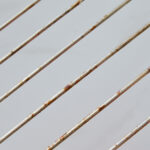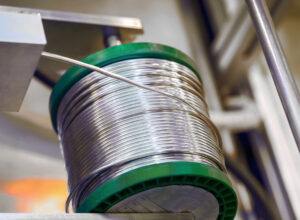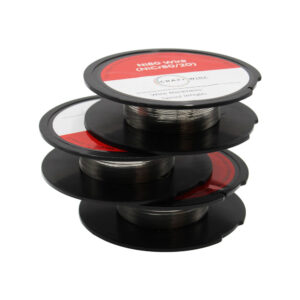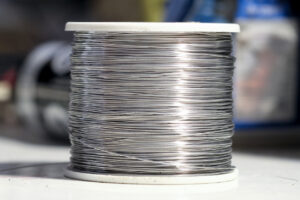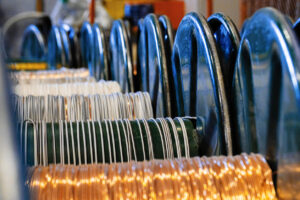The success of any angling expedition often hinges on a seemingly small, yet crucial element: the fishing wire.
Choosing the right fishing wire is not just a matter of preference but a strategic decision that can significantly impact the outcome of your fishing endeavors. The right wire can mean the difference between a rewarding catch and a lost opportunity.
Recognising this, Crazy Wire offers a diverse array of fishing wires, each designed to meet specific angling needs.
Whether you’re battling the fierce currents of a rapid river or the deep, salty waters of the ocean, our range of wires provides strength, flexibility, and durability. In this comprehensive guide, we’ll delve into the world of fishing wires, exploring how the right selection from our versatile collection can enhance your fishing experience and improve your chances of a successful catch.
Let’s get into it…
Understanding Fishing Wires
The fishing wire is a crucial link between the angler and the catch. In addition to being thrown into the water, they are engineered to withstand different environmental challenges while maintaining the sensitivity necessary for successful catching. Fishing wires connect bait or lures to anglers, enabling them to capture fish.
In general, fishing wires are strong, flexible, and resistant to the elements. Fishing for big game requires strength to handle the tension and fight from the fish. In order to avoid spooking the fish, flexibility is essential for casting and maneuverability, allowing the wire to move freely and naturally in the water. The wire must also be resistant to saltwater corrosion, UV radiation, and abrasion against underwater structures.
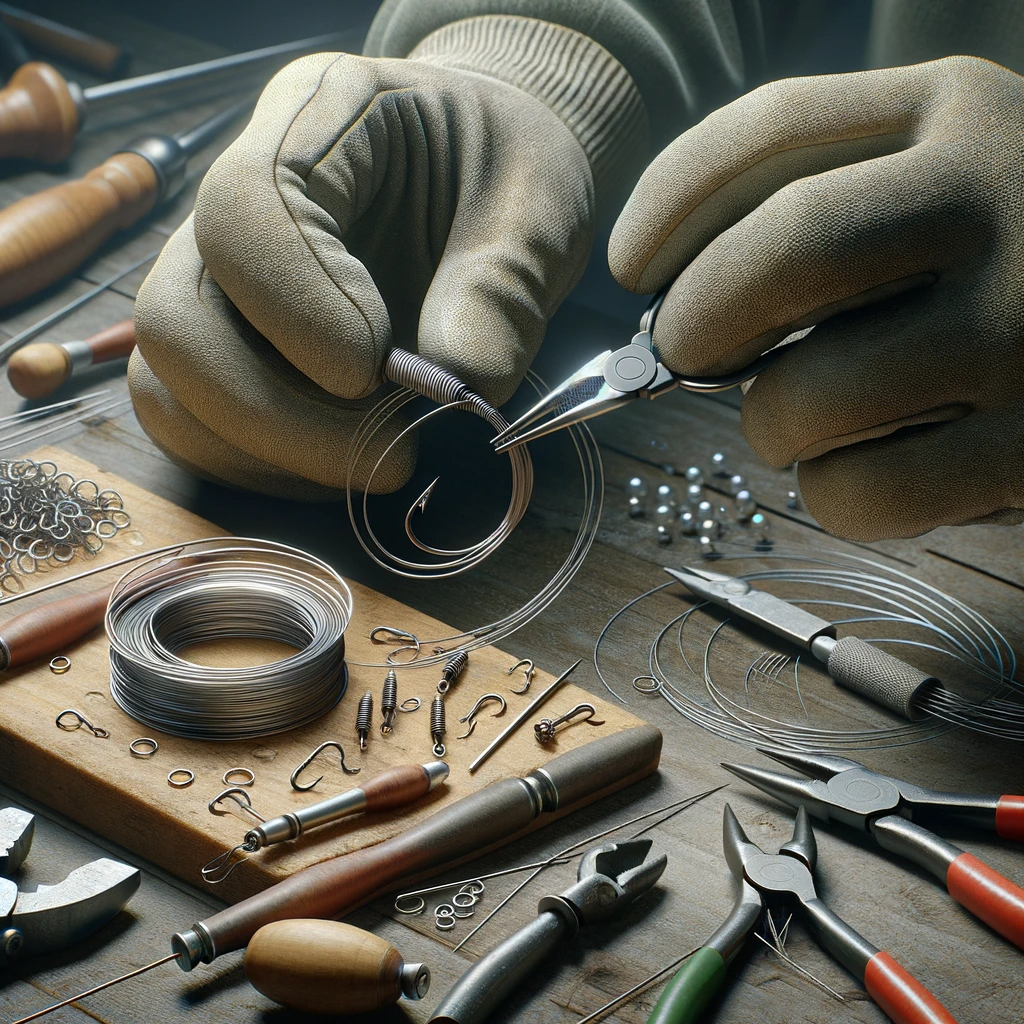
Traditional Fishing Lines: Pros and Cons
Monofilament Lines:
- Pros: Monofilament is stretchy, making it forgiving when fighting a fish, and it is generally the most economical choice. Beginners will also find it easy to handle and tie knots with.
- Cons: There are some downsides to this material, such as its susceptibility to UV light and memory (the tendency to coil). Furthermore, it’s less durable than other types, requiring more frequent replacements.
- Pros: With their strength and lack of stretch, braided lines offer greater sensitivity and longer casting distances. A strong, direct pull is ideal for deep-sea fishing.
- Cons: Braided lines are more visible in the water, which can be a disadvantage in clear conditions. They are also harder to knot and more expensive. When the water is clear, braided lines are more visible. Additionally, they are more expensive and harder to knot.
Fluorocarbon Lines:
- Pros: These lines are virtually invisible underwater, making them ideal for clear waters and wary fish. Additionally, they are abrasion-resistant and less susceptible to UV damage.
- Cons: Compared to other types of lines, fluorocarbon lines are stiffer and less sensitive. Additionally, they tend to be more expensive.
Each type of traditional fishing line has its unique advantages and limitations, making them suited for specific scenarios. Understanding these properties helps in selecting the right type of line for the fishing conditions you anticipate.
Stainless Steel Fishing Wires: Characteristics and Benefits
The exceptional properties of stainless steel fishing wires have made them popular among anglers, especially in challenging fishing situations. Fishing wires are made from stainless steel, which is known for its corrosion resistance and tensile strength.
Corrosion Resistance: The ability of stainless steel wires to withstand harsh environments, especially saltwater, is one of their most notable characteristics. The chromium content in stainless steel forms a passive layer that prevents corrosion and rust on fishing equipment. Saltwater is notorious for corroding fishing equipment, but stainless steel’s chromium content protects the wire. The durability of stainless steel wires in saltwater conditions makes them a perfect choice for ocean fishing.
Tensile Strength: Due to their tensile strength, stainless steel wires can handle the substantial weight and aggressive fighting of large fish. The wire must be able to withstand extreme tension without breaking when targeting species like tuna, marlin, or sharks.
Scenarios of Superior Performance:
- Stainless steel wires maintain their integrity much longer in saltwater environments, reducing the need for frequent replacements.
- Stainless steel provides the reliability needed to catch large, strong fish thanks to its robustness.
- Stainless steel lines are better suited for bottom fishing or areas with sharp rocks and structures because of their abrasion resistance.
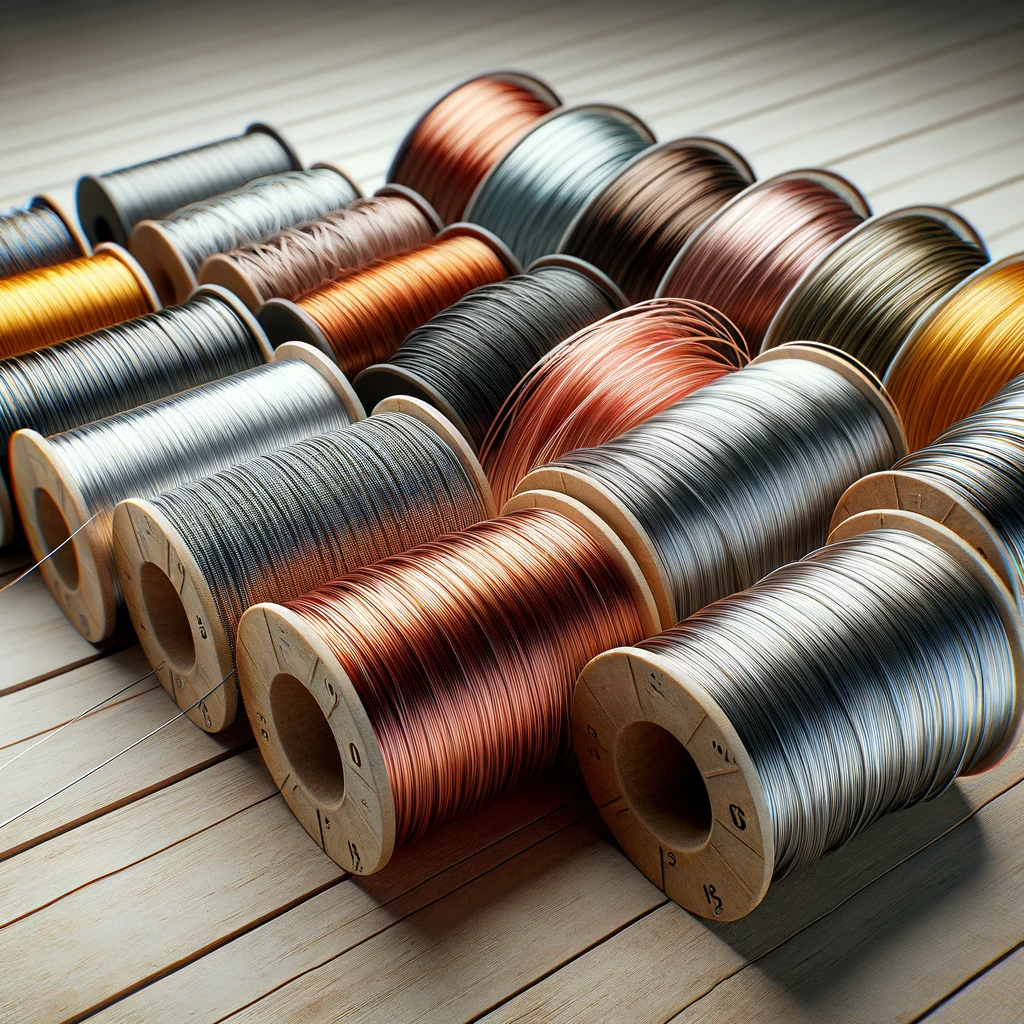
Comparative Analysis: Stainless Steel vs. Traditional Lines
When comparing stainless steel fishing wires to traditional lines, several criteria stand out:
Durability: In harsh conditions, stainless steel wires are much more durable than traditional lines. Abrasion, corrosion, and UV damage do not affect them, making them a long-lasting choice.
Adaptability to Environments: In saltwater and areas with physical obstructions, stainless steel wires excel while traditional lines are better suited for specific fishing techniques like casting or trolling.
Suitability for Different Fish Species: Wires made of stainless steel are ideal for targeting large and aggressive species. Traditional lines, on the other hand, are more versatile and are often preferred for smaller freshwater species.
User Experience: Due to their rigidity, stainless steel wires are less prone to tangling and are easier to maintain. Casting traditional lines is often easier and more flexible.
Guidance on Wire Selection
Choosing the right fishing wire depends on the specific conditions and target species:
- For saltwater and large fish, opt for stainless steel wires for their strength and corrosion resistance.
- Consider the fishing technique – stainless steel is better for bottom fishing and trolling, whereas traditional lines might be better for casting.
- Assess the water clarity and fish wariness; fluorocarbon or monofilament might be preferable in clear water conditions.
Using Standard Round Wire for Fishing: Feasibility and Applications
Adaptability of Standard Round Wire in Fishing
There is a surprising degree of adaptability to round wire that is commonly available on spools for fishing purposes. Because it can be moulded and shaped according to specific needs, it is an invaluable tool in an angler’s arsenal.
Custom leaders can be crafted using standard round wire. Especially when targeting toothy fish, leaders are vital for preventing line damage. Leaders made from round wire are strong and flexible, providing the necessary resilience against sharp teeth. Its ability to withstand the twists and turns of a struggling fish makes it ideal for this application.
Another area where round wire shines is in the construction of custom rigs. Anglers often require rigs tailored to specific environments or target species. This customization is possible with round wire. Wire can be manipulated to suit various rigging techniques, whether it is used in bottom rigs for sea fishing or float rigs for river fishing.
A standard round wire is also ideal for forming lure frames. Wire can be bent and shaped to form the skeleton of homemade lures, to which other components, such as hooks, feathers, or beads, can be attached. The cost-effectiveness of this solution allows for the creation of unique lures tailored to specific fishing conditions.
Selecting the Appropriate Wire Type
When choosing standard round wire for fishing, several key factors must be considered: the wire’s material properties, the fishing environment, and the targeted fish species.
Stainless Steel Wire: Due to its excellent corrosion resistance, it is ideal for saltwater fishing. This is particularly useful when fishing in oceanic environments where salty water can rapidly degrade less resistant materials. Durability and reliability are provided by stainless steel wire over time.
Galvanised Wire: A suitable option for freshwater fishing. Even though it does not offer the same level of corrosion resistance as stainless steel, it is strong and effective in environments where saltwater corrosion is not a concern. Additionally, it is generally more cost-effective than stainless steel, making it a good choice for occasional anglers or those on a budget.
Consider the wire’s strength and flexibility when selecting it. It must be strong enough to handle the weight and fight of the fish, yet flexible enough to be easily manipulated into leaders, rigs, and lure frames. Thick wires are stronger but less flexible, while thinner wires offer more flexibility but may not be able to withstand larger, more aggressive fish.
Customising Round Wire for Specific Fishing Needs
Customising standard round wire to create effective fishing tools is both an art and a practical skill that can significantly enhance your fishing experience. Here are some tips and ideas for shaping and manipulating round wire:
Cutting and Shaping:
- Use a good quality wire cutter to achieve clean cuts without fraying the wire.
- Pliers, especially needle-nose types, are essential for bending and shaping the wire. They allow for precision in creating loops, bends, and twists.
- A vise or clamp can hold the wire steady when making intricate bends or loops.
Creating Leaders:
- Cut a length of wire based on the depth and type of fishing. For toothy fish, longer leaders are advisable.
- Form a loop at one end for easy attachment to the mainline and another loop at the opposite end for the hook or lure.
- Crimping sleeves can be used to secure the loops, ensuring they hold under tension.
Building Rigs:
- For bottom rigs, use heavier gauge wire to form a sturdy frame to which weights and hooks can be attached.
- For float rigs, lighter and more flexible wire can be used, shaping small loops for attachment points.
Lure Frames:
- Shape the wire to form the backbone of a lure, creating attachment points for hooks and adding features like spinners or beads.
- Ensure the frame is balanced so the lure moves correctly in the water.
Practical Considerations and Tips
When working with round wire for fishing purposes, it’s important to consider both safety and maintenance:
Handling and Safety:
- Always wear protective gloves to prevent cuts and scrapes when cutting or shaping the wire.
- Work in a well-lit area to ensure you can see and handle the wire safely.
- Keep your tools sharp and well-maintained to make manipulation of the wire easier and safer.
Maintenance and Storage:
- After each use, clean the wire with fresh water, especially if used in saltwater environments, to prevent corrosion.
- Dry the wire thoroughly before storing it to avoid rust or degradation.
- Coil the wire neatly and store it in a dry place. Using a reel or spool can prevent tangling and makes it easier to dispense the wire when needed.
By customising round wire to suit specific fishing needs, anglers can create personalised and effective fishing tools. With careful handling, shaping, and maintenance, these customised wires can be a valuable addition to your fishing toolkit, providing tailored solutions for various fishing scenarios.
Determining the Right Thickness and Length of Round Wire for Fishing
Choosing the right wire thickness and length can significantly affect the success of a fishing expedition. Besides affecting the setup’s strength and flexibility, these choices also affect the wire’s visibility and behavior underwater, which can affect fish behavior.
Thickness Considerations for Different Fishing Situations
When selecting the thickness of round wire for fishing, anglers must consider the type of fish they are targeting and the environmental conditions.
For Larger Species: It is essential to use thicker wires when targeting larger, stronger fish species like tuna, marlin, or sharks. A wire that can withstand significant fighting strength and tension is required for these species. In such cases, wire thicknesses of 2mm or greater are often recommended. Although thicker wires are stronger and more durable, they are also less flexible and more visible underwater.
For Smaller Fish: Thinner wires, around 0.5mm to 1mm, are often more effective when fishing for smaller, more skittish species. In conditions of clear water where fish are easily spooked, these wires are ideal. The bait or lure can also be presented in a more natural and enticing way due to their greater flexibility.
Visibility and Fish Behavior: Underwater visibility is also determined by the wire’s thickness. In clear waters and for species that are line-shy, thicker wires may be more detectable by fish, which can serve as a deterrent. Visibility is less important in murky waters or when targeting less cautious species.
Length and Rigging Techniques
The length of the wire plays a crucial role in how the rig performs. Different fishing styles and conditions require varying lengths for optimal results.
Determining Wire Length:
- In bottom fishing, longer wires may be necessary to keep the bait near the seabed while allowing it to move.
- Trolling lure depth is determined by wire length.
- For floats, the wire should be long enough to suspend the bait at the desired depth.
Rigging Techniques:
- Leaders: For making leaders, the wire length should be enough to protect the line from being cut by the fish, usually a few feet.
- Lures: When rigging lures, the wire needs to be long enough to form the desired shape but short enough to maintain control and action.
- General Rigging: Consider factors like the type of fish targeted, water depth, and current. In stronger currents or deeper waters, longer wires may be needed to reach the desired depth and maintain bait presentation.
Customisation and DIY Approaches
DIY fishing with standard round wire not only enhances the fishing experience, but opens the door to creativity and personalized solutions. It is possible for anglers to experiment with various configurations, creating bespoke tools customized to their unique fishing styles and preferences.
DIY Leaders and Rigs: Leaders and rigs are among the most common custom uses of round wire. If anglers want to create a robust, tooth-proof leader for pike fishing, they can use thicker gauge stainless steel wire and add swivels and snaps to each end.
Homemade Lures: The process of crafting your lures using round wire can be particularly rewarding. The wire can be bent into a spoon or spinner shape, then hooks and reflective materials can be attached. As a result, not only does it save money, but it also allows the lure to be tailored to specific fishing conditions.
Case Studies: Innovative anglers have used standard round wire to solve unique fishing challenges in numerous instances. Anglers used thin stainless steel wire to create custom drop shot rigs for deep-water bass fishing, resulting in increased catches due to their subtle presentation.
Versatile Applications: Fishing gear can also be repaired and enhanced with round wire. Creating custom mounts and holders for fishing kayaks, or reinforcing the frames of damaged nets.
Standard round wire has a wide range of potential applications in the field of fishing. With its versatility, anglers can not only address specific fishing challenges, but also add a touch of personal craftsmanship to their fishing gear. For specific fishing needs, it is important to choose the right wire type and size. The right wire can make a significant difference when crafting a robust leader for saltwater giants or a delicate lure for freshwater game.
We offer also a massive range of stainless steel wire and nichrome wire through our store. Choose the wire that you want to work with and we’ll get spooling.
If you’re interested in learning more about wire, check out our other blog on Everything You Need to Know About Wires.
We are also proud to supply this product on our highly popular eBay store, check us out there too.
Thank you for checking out our site.
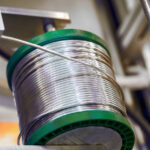
Nichrome Wire Safety: Top Tips for Working Safely
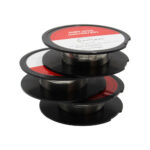
Best Wire for Electronics Projects
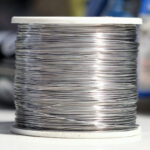
Is Ni80 Wire Suitable for DIY Heating Elements

Wire Grades Explained
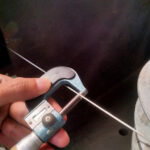
How Wire Diameter Affects Strength and Flexibility
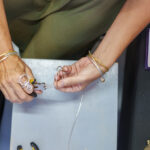
How to Cut and Shape Wire for Custom Applications

Can Wire Be Used in 3D Printing?

How Wire Composition Affects Conductivity
